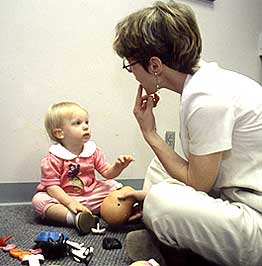 |
|||||||||
|
Research Feature Stories: Other News: |
Researchers Conduct Basic Science and Patient-Oriented Studies
Twelve years ago, UW researchers found that birds are capable of regenerating hair cells, the microscopic inner-ear cells that sense sounds and relay those sensations to the brain. Since then, researchers at the UW’s Virginia Merrill Bloedel Hearing Research Center have published more than 100 studies on hearing and hearing loss.
The center is named in memory of the hearing-impaired wife of the late Prentice Bloedel, who was founder and president of a major logging company. The center staff of more than 60—including 11 faculty members as well as postdoctoral fellows, graduate students and technicians—poses questions in both basic science and patient-oriented research. In addition, more than 50 UW faculty members from the School of Medicine and other units are affiliates of the Bloedel Center.
 |
Clinical audiologist Dr. Susan Norton plays an object-naming game for hearing-impaired toddlers. A variety of hearing research is conducted at UW’s Virginia Merrill Bloedel Hearing Research Center, including studies on Meniere's Disease and implantable hearing aids. |
Dr. George Gates, director of the Bloedel Center and professor of otolaryngology/head and neck surgery, studies age-related hearing loss, Meniere’s Disease, and cochlear implants. Dr. Edwin W. Rubel, professor of otolaryngology/head and neck surgery, physiology and biophysics, and neurological surgery, specializes in auditory system development and hair-cell regeneration.
For the past five years Gates has served as head of the center’s annual citizen’s conference “Ears, Hearing and Beyond” presented at the UW Husky Union Building (HUB). In spring of 2001, more than 500 attendees from around the region received information on the latest A-to-Z of hearing loss research and treatment.
According to Gates, new research in age-related hearing loss is concentrating on strial presbycusis. The stria vascularis is a part of the inner ear that provides energy for the hair cells and presbycusis is the medical term for hearing loss occurring with advancing age. Strial presbycusis is the short-circuiting or wearing out of an electrical current in the inner ear. Hair cells rely on this current for normal function. This theory may explain why hearing aids, which supplement hair cell action, work so well.
 |
|
These images by hearing researcher Dr. Jennifer Stone show immunolabeling for the hair cell marker, calmodulin, in normal auditory epithelium (left), damaged epithelium (center), and regenerated epithelium (right). Complete loss of hair cells occurs within three days after gentamicin treatment, but regeneration is evident nine days later. |
“Presbycusis may be like trying to start your car with a weak battery,” said Gates. “In our clinical studies we are asking ‘Are the hair cells gone or are they just under-powered?’
Bloedel Center researchers are also addressing the possibility of restoring hearing through hair-cell regeneration. In the October 2000 issue of the Proceedings of the National Academy of Sciences, Rubel and Dr. Jennifer Stone, research assistant professor of otolaryngology/head and neck surgery, documented in birds the sequence of events that creates new hair cells. The next step is to transfer this knowledge to hair-cell development in mammals.
Rubel and his colleagues have three main goals in basic science hearing research. One is to identify the cellular and molecular events that produce natural hair-cell regeneration in birds. The second is to determine whether regeneration can be induced in mammals by adding molecules already known to stimulate cell division elsewhere in the body. The third is to identify genes that inhibit cell division in the inner ear, because these genes may also inhibit hair-cell regeneration in mammals.
Another research program in Rubel’s laboratory focuses on the developmental plasticity of the central nervous system auditory pathways.
“If an animal is deprived of sensory information early in life, some of the associated neurons will die,” explained Rubel. “We want to know why and what we can do to prevent neurons from dying.”
Rubel predicts that human hair cell regeneration is 10 to 20 years down the road. In the meantime, the Bloedel Center will continue to open new paths in research and attract more investigators to the field.
“The wonderful thing about the UW is the number of absolutely outstanding laboratories,” said Rubel. “It’s a great opportunity to collaborate with researchers in a variety of different fields, from biological structure to genetics.”
Many individual contributors gave to the Virginia Merrill Bloedel Center for Hearing Research in 2000-2001. Several gifts were made in tribute to the tremendous impact that the center is having on restoring hearing and improving quality of life for the people of the Northwest. The center was established in large part with the support of several local Lions clubs and the national Lions organization.
|
| UW AMC Medical Center | UW School of Medicine | Harborview | UW MC | Search UW AMC | UW Home | Contact Us | ©2001-2002, University of Washington Academic Medical Center. All rights reserved. Please honor our copyrights. |
|